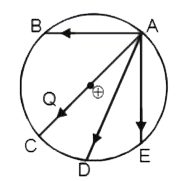A charge of 10C is moved in an electric field of a fixed charge distribution from point A to another point B slowly. The work done by external agent in doing so is 100J. What is the potential difference
?
To solve the problem, we need to find the potential difference VA−VB given the work done by an external agent in moving a charge in an electric field.
1. Identify the Given Values:
- Charge Q=10C
- Work done W=100J
2. Understand the Relationship Between Work Done and Potential Difference:
The work done W in moving a charge Q through a potential difference VA−VB is given by the formula:
W=Q×(VB−VA)
Rearranging this gives:
VA−VB=WQ
3. Substitute the Known Values:
Substitute W=100J and Q=10C into the equation:
VA−VB=100J10C=10V
4. Determine the Sign of the Potential Difference:
Since the work done by the external agent is positive, it indicates that the charge is moved from a lower potential to a higher potential. Therefore, we can conclude:
VA−VB=10V
Final Answer:
The potential difference VA−VB is 10V.
---
- Charge Q=10C
- Work done W=100J
The work done W in moving a charge Q through a potential difference VA−VB is given by the formula:
W=Q×(VB−VA)
Rearranging this gives:
VA−VB=WQ
Substitute W=100J and Q=10C into the equation:
VA−VB=100J10C=10V
Since the work done by the external agent is positive, it indicates that the charge is moved from a lower potential to a higher potential. Therefore, we can conclude:
VA−VB=10V
The potential difference VA−VB is 10V.
Topper's Solved these Questions
- BOOK - NARAYNACHAPTER - ELECTROSTATIC POTENTIAL AND CAPACITANCEEXERCISE - Evaluate yourself-15videos
ELECTROSTATIC POTENTIAL AND CAPACITANCE
- BOOK - NARAYNACHAPTER - ELECTROSTATIC POTENTIAL AND CAPACITANCEEXERCISE - Evaluate yourself-28videos
ELECTROSTATIC POTENTIAL AND CAPACITANCE
- BOOK - NARAYNACHAPTER - ELECTROMAGNETIC WAVES EXERCISE - EXERCISE -415videos
ELECTROMAGNETIC WAVES
- BOOK - NARAYNACHAPTER - ELECTROSTATICS AND GAUSS LAWEXERCISE - Intergers type question11videos
ELECTROSTATICS AND GAUSS LAW
Similar Questions
A charge is moved in an electric field of a fixed charge distribution from point A to another point B slowly. The work done by external agent in doing so is 100J . What is the change in potential energy of the charge as it moves from A to B ? What is the work done by the electric field of the charge distribution as the charge moves from A to B ?
View Solution1μC charge is shifted from A to B, and it is found that work done by an external force is 40μJ. In doing so against electrostatic forces, find potential difference VA−VB.
View Solution
Knowledge Check
- Question 1 - Select One
When a 2μC charge is carried from point A to point B, the amount of work done by the electric field is 50μJ. What is the potential difference and which point is at a higher potential ?
A25V,BB25V,AC20V,BDboth are at same potential. - Question 2 - Select One
In moving a unit positively charged body from point A to point B external work donw is 40 J and body acquires a kinetic energy of 20 J . The potential differnece VB−VA, is
A20VB−20VC40VD−40V - Question 3 - Select One
How much work is done in moving a charge of 5C across two points having a potential difference of 16V?
A65JB45JC40JD80J
The work done in moving a charge of 3 C between two points is 6J. What is the potential difference between the two points?
View SolutionFind the work done (in J) when a charge of 24 C moves across a potential difference of 6 V.
View SolutionFind the work done (in J) when a charge of 20 C moves across a potential difference of 4 V.
View SolutionIn the electric field of charge Q, another charge is carried from A to B, A to C, A to D and A to E, then work done will be :
 View Solution
View SolutionAn agent is moving a positively charged body towards another fixed positive charge. The work done by the agent is
View Solution

